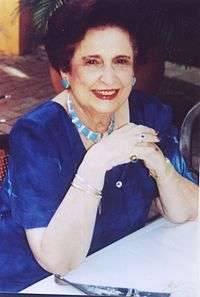Teresa Román Vélez

Teresita Román de Zurek (Cartagena, Colombia, 29 December 1925) is a Colombian writer and chef.[1]
Biography
Teresita Román began working at the Colombian Red Cross in the Department of Bolivar in the mid 1960s. She founded the association "Damas Grises" and was its regional president from 1992 to 2000. After that she was named Honorary National President. Throughout her life she has been awarded numerous prizes, both for her enormous contribution to Colombian culture and its preservation, as well as for her active public life which has been dedicated to those who need it the most and for the preservation of Colombia's most valuable treasure: the city of Cartagena. In 2006 she was named Honorary Mayor of the City of Cartagena de Indias.
Publications
In 1963, she published the first edition of Cartagena de Indias en la Olla, her very first cookbook which has since been published in 45 editions, both in Spanish and English. Cartagena de Indias en la Olla has been recognized with numerous awards all over Colombia and in the United States. In 1998 she published Mis Postres, a small cookbook entirely dedicated to desserts, almost entirely to chocolate. In 2004, she received a distinction from the Popayan Cooking Festival for her work to preserve the native cuisine of Cartagena. Teresita Román de Zurek also belongs to the internationally renowned Chaîne des Rôtisseurs.
Casa Museo Rafael Núñez

The Fundación Casa Museo del Cabrero, is the organization that works for the preservation of the legacy of Colombian President Rafael Nuñez. It was founded by the late historian Eduardo Lemaitre and after his death succeeded by Teresita Román de Zurek. The historic Rafael Nuñez House, a museum, is located in the Cabrero neighborhood in Cartagena.
Magazine article
"If Willy is the unofficial mayor of Cartagena's streets, then Teresita Román de Zurek presides over the life behind its gates. She is one of the city's grand dames, the matriarch of its most prominent family, and Cartagena's honorary mayor, a title given her for her many civic contributions, including a best-selling cookbook on the local cuisine, and her leadership in returning horse-drawn carriages to the city center. (A friend of mine correctly points out that the horses' canter on the pavement sounds like Cartagena-Cartagena-Cartagena.)Teresita lives behind the gates of Casa Román, possibly Cartagena's most famous private home. It's an extravagant nineteenth-century Moorish fantasy whose arched windows are copied directly from the Alhambra in Spain. The house is built around a tiled courtyard, and doors lead to sitting rooms and bedrooms. Teresita was born in this house over eighty years ago (it seems rude to ask the precise date). She is a handsome, stately woman with well-coiffed reddish-brown hair. Her earrings are two large hunks of lapis lazuli. Teresita comes from a family of famous chemists who emigrated from Spain in the early nineteenth century. The first Román in South America washed up near Cartagena's beach after his Lima-bound ship went down. Despite this inauspicious beginning, the Románs have held positions of prominence in the city for almost two hundred years. A nephew is the former mayor. Her father invented Kola Román, an eclectic-pink soda popular throughout the region. Her cookbook features a number of recipes that use Kola Román imaginatively, including plantains marinated in Kola Román and Kola Román fruit cocktail. As Teresita is telling me about her recipes, her maid offers me an ice-cream soda made with Kola Román. It tastes like bubble gum.
Teresita is also known and loved for her collection of 1,470 dolls (reportedly the largest in Colombia) representing the nations of the world. She began the collection in 1948 with a Romería del Rocío baby doll in a frilly linen skirt. One of her most recent acquisitions is a Shakira doll, which stands in a prominent place in the Colombian group. Teresita keeps her collection in glass displays that fill a corner room in Casa Román. When I visited, three assistants were busy labeling, cataloguing, and cleaning the dolls.
If Teresita Román de Zurek sounds like a character out of a Gabriel García Márquez novel, it's because she is. Several years ago, "Gabo", as everyone around here calls him, published a book of short selections from his many novels and stories accompanied by photos of the people who had inspired characters in his work. There's a picture of Teresita in her drawing room with dozens of broken plates on the floor. Behind her is a collection of Napoleon-era ladies' fans—a gift from a suitor when she was a girl, Teresita tells me. She sent him packing but kept the fans. Teresita's nephew Antonio de Pombo Román tells me that García Márquez didn't invent magical realism. He just looked around and wrote everything down." Taken from: EBERSHOFF, David. SLEEPING BEAUTY. Condé Nast Traveler Magazine, March 2007
See also
References
- ↑ El fogón de D'Artagnan - Page 249 Roberto Posada García-Peña, Benjamín Villegas - 2005 "Y así también lo describe Teresita Román de Zurek en su estupendo libro Cartagena de Indias en la olla, cuando ordena, con pelos (?) y señales, las siguientes instrucciones para preparar, sin reatos y en cualquier parte del mundo , ..."
- http://www.cartagenacaribe.com/cultura/cocina.htm
- http://www.univision.com/content/content.jhtml?cid=768468
- http://www.ocexcelsior.com/mi_cocina/0715/0715_mi_cocina_er_sancocho.shtml
- http://www.concierge.com/cntraveler/articles/detail?articleId=10622&pageNumber=5
- http://www.alcaldiadecartagena.gov.co
- http://www.teresitaromandezurek.com
- Concierge.com